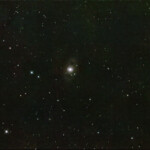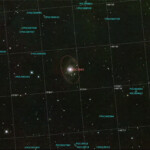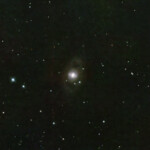NGC 3945 is a barred lenticular galaxy at a distance of 73 million light-years in the constellation Ursa Major. It was discovered on March 19th, 1790, by the astronomer William Herschel.
NGC 3945 has a complex structure, with two concentric bars and a pseudobulge. Unlike classical bulges which are like miniature elliptical galaxies, pseudobulges have features similar to disk galaxies, including a flattened structure and significant rotation. It is classified as a low-ionization nuclear emission-line region (LINER) galaxy. The formation history of NGC 3945 is likely quite complex, with the pseudo-bulge being formed gradually from disk material, while bulges (spheroidal components) would have formed from violent merger events.
Unlike galaxies with similar velocity dispersions and luminosities, the central black hole of NGC 3945 has an unusually low mass, estimated to be around 9×106 M☉. However, it is also possible that NGC 3945 has no central black hole at all.
NGC 3978 is a large intermediate spiral galaxy with a bar located in the constellation of Ursa Major. It is located 460 million light-years away from the Solar System.
NGC 3978 has a luminosity class of II-III and it has a broad H II region which contains regions of ionized hydrogen. In addition, it is categorized as a LINER galaxy meaning its nucleus presents an emission spectrum which is characterized by broad lines of weakly ionized atoms,
NGC 3978 and NGC 3975 probably form a galaxy pair with each other.


